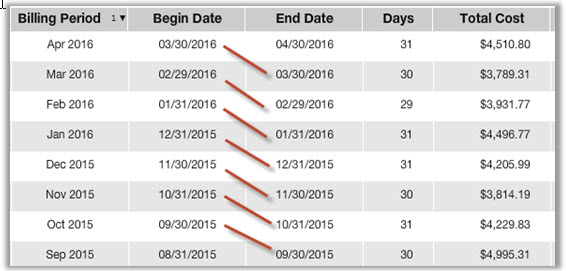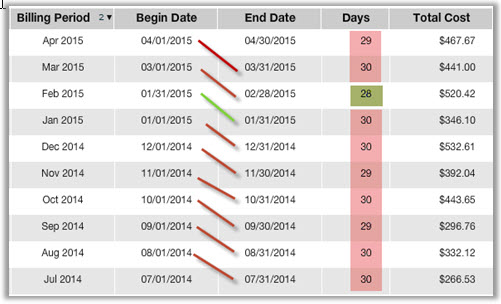In a perfect world, all of your utility meters would trip their odometer readings at 12:00 a.m. on the first day of every calendar month, all your utility bills would reflect the energy you used for precisely that period, and all planes and trains would run on time. Your relationship with your energy data would be perfect, and you wouldn’t need dating rules!
In the real world, things are a bit messier. But how we handle that mess determines the accuracy and reliability of our energy metrics. Today’s blog explains a few EnergyCAP best practices for handling the available energy data to assure the most reliable outcome. Regardless of your energy management system or analytics practices, this topic should be relevant!
Assumptions and Limitations
Most utility companies treat bill Start Dates and End Dates in same way. The day on which the meter is read is both the End Date of the current bill and the Start Date for the next bill.
This makes sense because utility companies have historically read meters via an on-foot meter reading technician who walked from meter to meter during normal business hours and entered each reading into a ledger or (later) a hand-held data recorder of some type.
Today, meter reading technology includes remote systems using drive-by vehicles, pole-mounted data accumulators or other technologies. But regardless of the hardware or software being used, the meter is still read on a specific day, which is seldom the first day of the calendar month. And that single day is treated as both the End Date of one billing period and the Start Date for the next.
However, with smart electric meters becoming more common, some metering systems have the capability to compile, store and transmit detailed usage data on a “per day” basis. As a result, some bills are reflecting a billing period that ends at midnight on one day, while the next bill begins just after midnight on the following day. Some utility companies are providing historical data in spreadsheet format in which the data has been manipulated to show calendar months, not billing periods. Spreadsheet calendarized data may run March 1 to March 31, instead of March 1 to April 1, for example.
Rules for Reliability
For purposes of consistency in obtaining energy metrics for analytics, EnergyCAP software (and its precursor products) have followed a rule that was instituted in 1982 and has remained unchanged ever since. Utility meters are assumed to be read at noon, and that day is both the End Date of the current bill and the Start Date of the next.
A typical bill list in EnergyCAP’s utility database illustrates this concept:

For purposes of energy accounting, however, it is important that the Start/End Date day not be counted twice. For example, if March 30 was counted as both a March day and an April day, it would be counted twice, and the year would have 12 days too many. This would adversely impact the accuracy of use-per-day and cost-per-day calculations, affecting the reliability of audits, budgets and other analytics.
So the bill date rule needs a corollary rule to avoid confusion with half days vs. full days and double-counting.
In EnergyCAP, the corollary rule states that the start day of the billing period is counted as a full day and the end day is not counted. In the above example, the April billing period includes the full days of March 30 to April 29. This is a billing period length of 31 days (two in March and 29 in April).
Correcting Inconsistencies
So what happens when the vendor bills don’t end and start on the same day? Here’s an example:

You can see that this natural gas vendor prefers to bill on a calendar month basis, setting the Start Date to be the day after the prior bill End Date in nearly every instance. Since EnergyCAP ignores the last day of the bill per the rule described above, each month has one day too few for purposes of use-per-day and cost-per-day calculations. Curiously, the February bill starts on the same day as the January bill ended, so the February day count in EnergyCAP is correct “as is.” However, all the other months are a day short in the billing period.
In the above example, most of the bills for the “short months” could be corrected in EnergyCAP by changing the End Date to the first day in the next month, e.g. the March billing period could be 3/1 to 4/1. Then the 4/1 End Date would not be counted in the March billing period (per the EnergyCAP rule), yielding a correct 31-day bill.
What are the ramifications of the above scenario if this correction is not made? As noted, the day count is one day too low, so use-per-day and cost-per-day calculations will be about 3% too high. Use-per-day and cost-per-day are metrics used in a number of different ways in EnergyCAP including:
- Audits
- Calendarization and normalization
- Budgets
- PowerView charts
- Reports
- Accruals
- Cost Avoidance
All these functions would be affected by the billing date issue!
 Best-in-class portfolio-level energy and utility bill data management and reporting.
Best-in-class portfolio-level energy and utility bill data management and reporting.
 Real-time energy and sustainability analytics for high-performance, net-zero buildings.
Real-time energy and sustainability analytics for high-performance, net-zero buildings.
 A holistic view of financial-grade scope 1, 2, and 3 carbon emissions data across your entire business.
A holistic view of financial-grade scope 1, 2, and 3 carbon emissions data across your entire business.
 Energy and sustainability benchmarking compliance software designed for utilities.
Energy and sustainability benchmarking compliance software designed for utilities.




